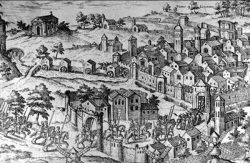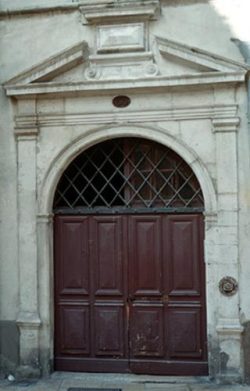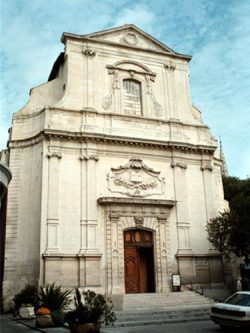Nîmes (Gard)
In the 16th century Nîmes was already one of the great Protestant shrines ; the mumerous Temples were former Catholic buildings used by the Protestants after the Concordat (1801).
The first Temple in Nîmes, the Cathedral of Saint-Castor
In 1561, the reformer Pierre Viret celebrated the Christmas service in the Cathedral of Saint-Castor, the first worship place of the Reformed.
On 15 January 1562 Reformed worship took place officially, with 8,000 receiving Holy Communion. The interior of the Cathedral was reorganised for the Protestants, who lowered the pulpit, put in benches and a wooden floor. Demolished twice during the Wars of Religion, the Cathedral was rebuilt in 1646. After the Revocation many Huguenots were executed in front of the Cathedral. The only remains of the building are the tower, the 14th century machinolations, and the 15th century bell tower.
The Calade temple
In 1565, Charles IX and his mother Catherine de Médicis went through Nîmes. The Reformed representatives handed them their written grievances. Charles IX conceded two plots of land to build the Temple of the Calade.
The rectangular building, 30m long and 48m wide, to hold 5,000 worshippers, opened on the square in la Calade through a portal. Over the portal were engraved the words “this is the house of God, this is the doorway to heaven” (C’est ici la maison de Dieu, c’est ici la porte des cieux ). This inscription was erased in 1795 but copied on the tympanum of the Small Temple, the chapel of the Celestins attributed to Protestant services in 1793.
Inside, tribunes were supported by arched vaults as in the temples of Vialas and Collet-de-Dèze.
In 1685, at the Revocation, the temple was dismantled. During the 18th century, a religious congregation used the stones to build a school. They put the front portal back into use. The bell was sold for 1,000 francs to Calvisson, a neighbouring city, and today still has its place in the town-hall.
The Temple of Saint-Marc
In 1601, a beam in the Temple of the Calade seemed about to give way, and a second temple was built. Built in 1610, the small temple of Saint-Marc was situated in the Grande Rue (Main Street), across from Trélis street. It was demolished in 1663.
The Small Temple (Ursuline Temple)
During the 18th century many a Protestant young lady was forcibly converted by the Ursulines in the chapel and monastery built between 1714 and 1718.
At the Revolution the chapel and the Ursuline convent became national property and were sold. The chapel was bought by a Protestant. After being lent out for worship, it became the property of the Reformed community in 1831.
The Great Temple (Dominican Temple)
From 1787, thanks to Rabaud Saint-Etienne’s intervention, religious freedom was restored. In 1791 the Protestant community rented the convent’s chapel, built in 1714 in the Baroque style by the Dominicans, on the ruins of the royal castle. It became national property at the Revolution, and was bought in 1803, at an auction, by the consistory of Nîmes.
The present façade dates from 1843.
Nîmes (Gard)
Bibliography
- Books
- DUBIEF Henri et POUJOL Jacques, La France protestante, Histoire et Lieux de mémoire, Max Chaleil éditeur, Montpellier, 1992, rééd. 2006, p. 450
- LAURENT René, Promenade à travers les temples de France, Les Presses du Languedoc, Millau, 1996, p. 520
- REYMOND Bernard, L’architecture religieuse des protestants, Labor et Fides, Genève, 1996
Associated notes
-
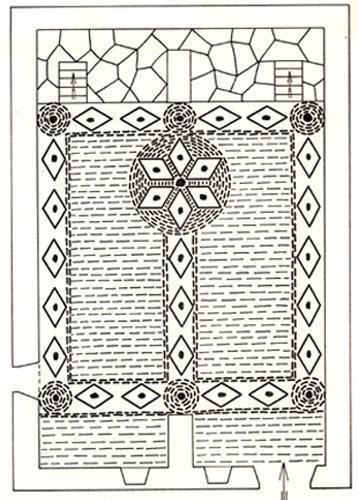
Collet-de-Dèze (Lozère)
Collet-de-Dèze is the oldest temple in France. Protestantism was established in the valley of the Gardon as soon as 1566. -

Vialas (Lozère)
After the Edict of Nantes, the Protestant population of Vialas was large enough to have a temple built in 1612 at its own expenses. The Reformed, being merely tolerated by... -

Pierre Viret (1511-1571)
Pierre Viret devoted his life to teaching theology and spreading the Reformed faith. He was known as an outstanding preacher. -
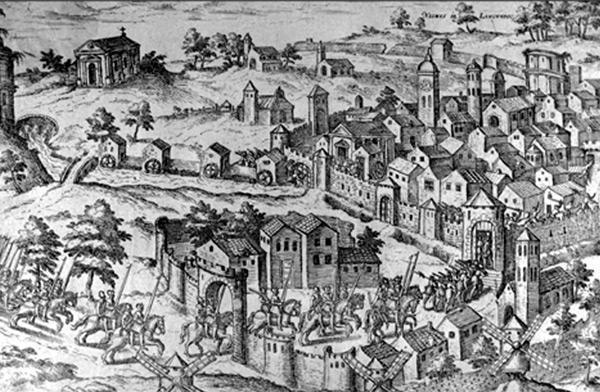
Nîmes et ses environs

